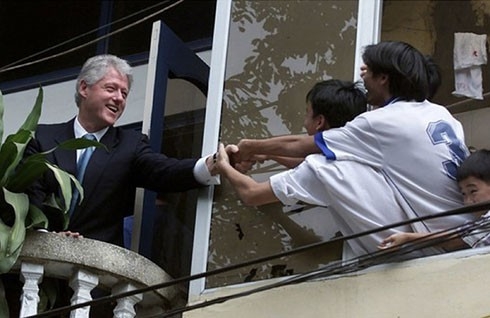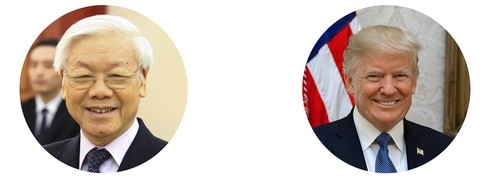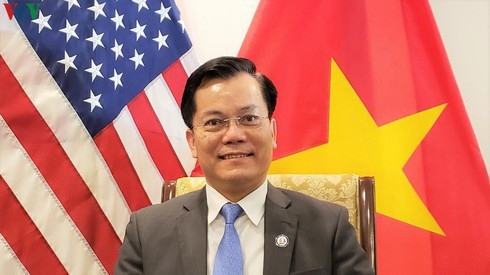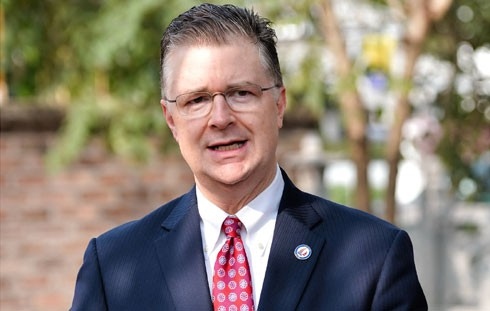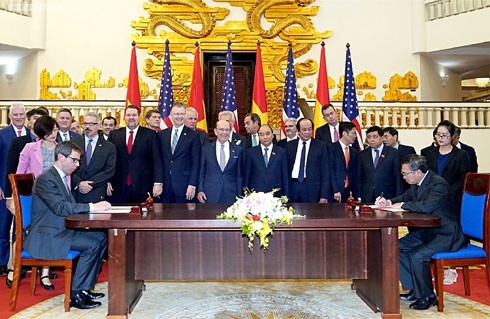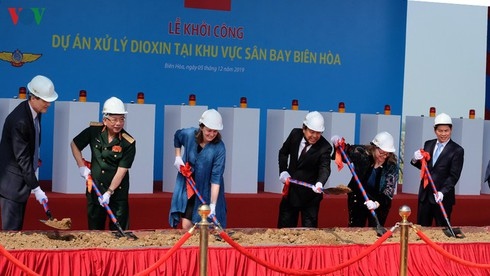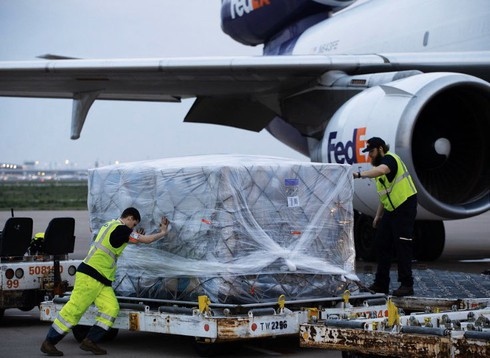Vietnam, the US confident of brighter partnership future
VOV.VN - Vietnam and the US have undergone many upheavals to build up trust and become friends over the past 25 years. Both countries have established the comprehensive partnership and they are now looking forward to a better future.
Vietnam, the US confident of brighter partnership future
Vietnam and the US have undergone many upheavals to build up trust and become reliable partners over the past 25 years. Both countries have established the comprehensive partnership and they are now looking forward to a better future.
Marking the 25th anniversary of the establishment of diplomatic ties between Vietnam and the US, VOV.VN sheds light on significant milestones in bilateral cooperation over the years.
25 years ago on July 11 (Washington time) US President Bill Clinton announced the normalization of relations between the US and Vietnam. At the same time from Hanoi, Vietnamese Prime Minister Vo Van Kiet announced the establishment of diplomatic ties between Vietnam and the US.
Before this “historic moment”, Vietnam-US relations had experienced many ups and downs for nearly half a century, and it was President Ho Chi Minh who laid the initial foundation for establishing the diplomatic ties between the two sides.
Hard to imagine
Since the normalization, Vietnam - US relations have gained numerous achievements, which are described by both sides as “impressive” or “hard to imagine”. From reservations and doubts, bilateral ties have improved over the years, and the two countries established the comprehensive partnership following the US visit in 2013 by Vietnamese President Truong Tan Sang.
Back in August 1995, US Secretary of State Warren Christopher visited Vietnam, paving the way for the opening of the US Embassy in Hanoi and the Vietnamese Embassy in Washington DC.
Two years later, Pete Peterson was appointed the first US Ambassador to Vietnam, and diplomat Le Van Bang presented his credentials to the US President, becoming the first Vietnamese ambassador to the US.
The two countries achieved a breakthrough in bilateral relations when Defence Secretary William Cohen made a visit to Hanoi in March 2000, the first of its kind by a US Defence Secretary. Four months later, Vietnamese Trade Minister Vu Khoan penned a Vietnam-US Bilateral Trade Agreement with US Trade Representative Charlene Barshefsky.
In late 2000 US President Bill Clinton arrived in Vietnam for an official visit, becoming the first US President to visit Vietnam since the normalization of Vietnam-US relations.
Five years later, Prime Minister Phan Van Khai paid a visit to the US, the first of its kind by a Vietnamese leader, paving the way for reciprocal visits by the two countries’ top leaders.
2020 – A special year
To celebrate 25 years of Vietnam-US diplomacy in 2020, the two countries’ top leaders exchanged letters of congratulation.
In his letter, Party General Secretary and President Nguyen Phu Trong expressed his belief that in the spirit of putting aside the past, overcoming differences, promoting similarities and moving forward to the future, the comprehensive partnership between Vietnam and the US will be further developed in an effective and sustainable manner, in the interest of the two peoples and contributing to peace, security and prosperity in the region and the world.
Meanwhile, in his letter, US President Donald Trump affirmed that the United States maintains its commitment to further strengthening relations between the two countries on the basis of a shared vision of a peaceful and prosperous Indo-Pacific region, as well as respecting each other’s legal system and sovereignty.
Three major achievements
In a recent interview granted to Washington-based VOV correspondents, Vietnamese Ambassador to the US Ha Kim Ngoc said that the comprehensive partnership between Vietnam and the United States has yielded three major achievements.
“First, with the vision and political determination of the two countries’ leaders, the two sides have overcome many difficulties and obstacles to establish the comprehensive partnership, in the spirit of putting aside the past and looking to the future, on the basis of respect for the United Nations Charter and each other’s independence, sovereignty, territorial integrity, as well as political regime.
“Second, bilateral cooperation has reached a level that no one could have imagined 25 years ago, from both the scope and scale of cooperation. Impressive results have been recorded not only in political and diplomatic relations, but also in other cooperation fields, such as economics, trade, investment, security, defense, education, culture, people-to-people exchange, science-technology, and from bilateral and regional to global cooperation.
“Security-defense relations witnessed solid developments, not only in dealing with the aftermath of the past war, but also expanded into military medical training, humanitarian relief cooperation, disaster assistance, and peacekeeping. For the first time, the US Government provided funds channeled through the Department of Defense to assist Vietnam in the search for soldiers missing in action during the war.
“Third, the strong Vietnam - US relationship also makes a positive contribution to maintaining peace, stability, cooperation and respect for the rule of law in Indo - Asia – Pacific and the world at large”.
Trust building
Meanwhile, US Ambassador to Vietnam Daniel Kritenbrink noted that the US-Vietnam partnership is the strongest it has ever been.
“Today we can sincerely call one another friend and partner…… It is extraordinary how quickly we have made progress and how quickly and successfully we have built partnership and friendship between the US and Vietnam. We should be proud of that.”
“We are eager to build trust between the US and Vietnam, making sure that economic and trade relationship is increasingly fair, free and balanced.”
Kritenbrink affirmed “Our futures are linked… We are very optimistic about the future and what we can achieve together in the next 25 years.”
His remarks are evidenced by the ‘miraculous’ development in bilateral economic cooperation, as he noted “It has gone from virtually no trade to a US$77 billion bilateral trade flow.”
Flouring trade
It’s worth mentioning that after President Bill Clinton announced the lifting of the trade embargo against Vietnam on February 3, 1994, two-way trade had grown from just US$500 million in 1994 to US$1 billion in 2000.
Bilateral trade relations had only flourished after the Vietnam - US Trade Agreement (BTA) was signed and took effect in late 2001. Two-way trade value has increased by 20% annually on average, from US$6.75 billion in 2005 to US$18.1 billion in 2010, US$41.28 billion in 2015, and US$US$75.72 billion in 2019.
After the BTA came into effect, the United States continued to apply the Normal Trade Relations and Most-Favored-Nation (MFN) status with Vietnam, by reducing the average tariff rate on Vietnamese imports from 40% to 4 %, and opening the door for Vietnamese exporters.
In December 2006, President George W. Bush decided to grant Vietnam the Permanent Normal Trade Relations (PNTR) status, paving the way for numerous leading US firms such as Intel, Microsoft, Jabil, Microchip, IBM, P&G, Coca-Cola, PepsiCo, and then Boeing, Chevron, AIG, Exxon Mobil, General Electric, to seek investment opportunities in Vietnam.
2020 is a special year as it marks the 25th anniversary of diplomatic ties between Vietnam and the US. Despite the negative impact of the COVID-19 pandemic, Vietnam has attracted big US digital giants such as Google and Apple.
Meanwhile, Ford has decided to increase production capacity by investing in an assembly plant in Hai Duong province. General Electric has also increased its investment in wind farms in Hai Phong City. AES, a major US energy firm, has been licensed to deploy LNG gas project in Son My (Quang Ngai province). Silicon Valley-based technology firms have planned to shift electronics production lines to Vietnam.
Dealing with war aftermath
Overcoming war consequences has been a top priority in bilateral cooperation since the two countries normalized diplomatic relations. Both countries have worked closely in the search for soldiers missing in action (MIA), landmine clearance and dioxin detoxification.
To date Vietnam has handed over 150 sets of remains of US soldiers to the US. In contrast, the US Government and war veterans’ organizations have also collaborated with Vietnam in providing information about Vietnamese MIAs.
In addition to the MIA search efforts, the two sides have completed the detoxification of dioxin at Da Nang airport, and have now begun to clean up the dioxin-contaminated Bien Hoa and Dong Nai airports.
Both Vietnam and the United States are aware such cooperation brings mutual benefits, alongside other priority areas of cooperation, such as trade, security, environmental protection and climate change. This is not only a matter of overcoming the consequences of the past war but also creating a basis for mutual trust for future cooperation between the two sides.
True friends
The US and Vietnamese governments have cooperated extensively in the fight against COVID-19. A shipment of 450,000 “Made-in-Vietnam” protective suits was delivered to the US from Vietnam last April, to help the country combat COVID-19. As soon as the shipment arrived in Dallas, President Donald Trump twitted: “This was made possible because of the partnership of two great American companies—DuPont and FedEx—and our friends in Vietnam. Thank you!”
Since the beginning of the coronavirus outbreak, the US Centers for Disease Control and Prevention (CDC) and the United States Agency for International Development (USAID) have been collaborating with relevant Vietnamese agencies in monitoring and responding to the complex development of the COVID-19.
US Ambassador to Vietnam Dan Kritenbrink stated: “Over the past 20 years, the US has invested more than US$706 million in health assistance for Vietnam, and over the past decade has provided substantial technical and financial support to prevent, detect, and respond to emerging and serious infectious diseases. These investments by our two countries are paying off at this critical time.
“The connections established between American and Vietnamese health professionals have been instrumental as we fight this epidemic together. This shipment will help protect health care professionals working on the front lines against COVID-19 in the US and demonstrates the strength of the US-Vietnam partnership.”
To conclude, Vietnam and US have not only promoted bilateral cooperation in various areas but supported each other in overcoming difficult times. This testifies to the notion of mutual assistance in difficulty, creating a new foundation for elevating the Vietnam-US relationship to a new height.


